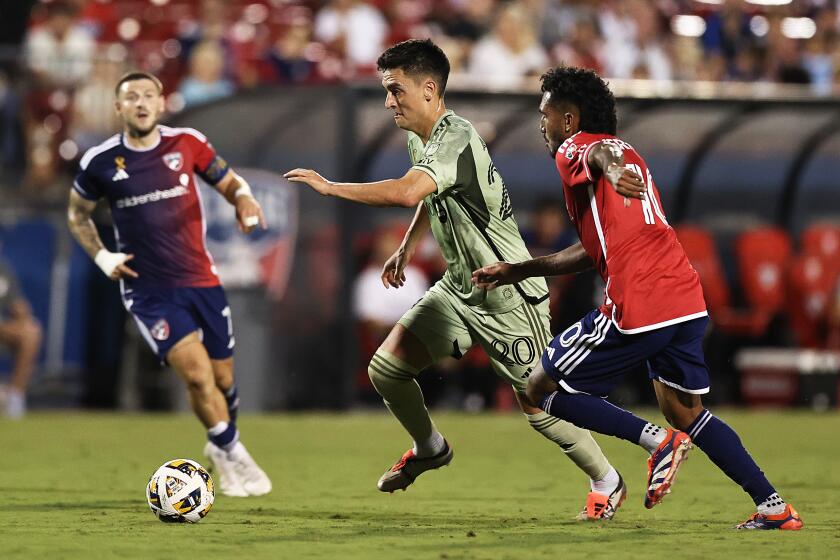Class of Titans
Alana Beard and Diana Taurasi are, by most accounts, the top players in college women’s basketball. More importantly, experts say, they personify the next step in the evolution of the women’s game.
“I compare it to when Magic [Johnson] and [Larry] Bird came into the NBA,” said Kelly Krauskopf, chief operating officer of the WNBA’s Indiana Fever. “That’s a hard legacy, but it’s the only one we know.
“When you talk of changing the face of our league, they are the players who can potentially do it.”
Duke’s Beard, who averages 21.8 points and was the Atlantic Coast Conference player of the year, and Connecticut’s Taurasi, who averages 16.3 points and was the Big East Conference player of the year, are quick, strong, smart and skilled at ballhandling, passing and shooting.
Just as significant, they are charismatic personalities who helped generate unprecedented interest in women’s basketball last month when they faced each other in a regular-season game.
Played at Duke before a standing room-only crowd and a national television audience on ESPN2, the game drew viewers from 1.226 million households, making it the most watched regular-season women’s game on ESPN and ESPN2 in 20 years.
“It was a big story and it created interest in fans who may not have been interested to start with,” ESPN spokesman Josh Krulewitz said.
The Great Wait
The anticipated arrival of players who might propel the WNBA into new markets and more homes has league officials salivating.
There’s just one problem: Beard and Taurasi -- and most of the college game’s other top players -- are juniors, still more than a year away from joining the league, which is at a critical juncture in its development.
Underwritten by the NBA in its previous six seasons, the WNBA will operate with independently owned franchises for the first time. And those owners have yet to agree with the players on a labor contract.
In order to solidify its place on the national sports map, the WNBA needs to have the top college stars matriculate directly into its ranks. But many are lured to overseas leagues by lucrative contract offers.
The absence of big-money contracts -- many WNBA players make less than $50,000 a season -- is among the reasons neither Taurasi nor Beard say they are tempted to make themselves eligible for the WNBA draft before finishing their senior seasons.
“There is more emphasis on women getting their degrees, because you don’t have the luxury of money in the pros,” Taurasi said. “The money is not to a point where it can take care of you the next 25 years.”
Added Beard: “Right now, with my degree from Duke, I can make more money [working] than by playing in the league.”
Class of the Classes
The Class of 2004 is deep, and good players come from every corner of the nation.
Taurasi attended high school in Chino but now, like Beard, she plays in the East. In the West, Stanford’s Nicole Powell, at 6 feet 2, can play any of the five positions and last year was the first player -- male or female -- to lead the Pacific 10 Conference in rebounding and assists.
“Versatility is where we stand apart,” Taurasi said. “Me, Alana and Nicole are a little out of mold. We’re all big, can play, and we have fun.”
Between are such gems as Kansas State’s Nicole Ohlde, a 6-4 post player who is the Big 12 Conference player of the year; Penn State’s Kelly Mazzante, a 6-0 guard who reached 2,000 points faster than any other Big Ten woman player (88 games); Purdue’s Shereka Wright, a 5-10 forward who averaged 19.4 points and 6.2 rebounds despite playing part of the season with a broken bone in her left hand; and Texas’ Stacy Stephens, a 6-1 forward who is among the strongest inside players in the nation.
And then there are such lesser-known talents as Harvard’s Hana Peljto, a 6-2 forward who was the Ivy League’s top scorer; Houston’s Chandi Jones, a 5-10 guard who averaged 27.5 points; and Cincinnati’s Valerie King, who has led the Bearcats in scoring the last three seasons.
“It’s an incredible crop of players who can immediately start in the [WNBA],” said Johnny Buss, president of the Sparks.
Said Texas Coach Jody Conradt: “We’ve always had standout players, but not in the numbers we have now. There is so much versatility emerging; you can’t just pigeonhole people as a post player or a perimeter player. They can do everything on the court, and that is changing our game.”
Closing the Gender Gap
Taurasi and Beard both lived up to billing in their January showdown, won by Connecticut, 77-65.
Despite a sore left ankle, Taurasi swished a couple of three-point baskets and, on a fastbreak, zipped -- from half court -- a no-look chest pass to Jessica Moore for an easy layup.
Though stifled early, Beard scored 21 of her game-high 26 points in the second half, speeding through the defense for layups or medium-range jumpers as the Blue Devils cut a 28-point deficit to six late in the game. Twice when Taurasi had the ball, the long-limbed Beard tapped it away, recovered it and drove to the basket for uncontested layups.
Once the score became close, Taurasi calmly made a couple of key shots.
“Great players make everyone else around them better,” Connecticut Coach Geno Auriemma said. “That’s what these two kids do.”
Jerry Reynolds, the general manager of both the NBA’s Sacramento Kings and the WNBA’s Sacramento Monarchs, sees the gap in talent between men and women closing.
“There’s no doubt the women’s game is improving dramatically,” the former NBA coach said. “You can see it in the athleticism. I don’t think there’s any doubt the women are improving more than the men in talent and interest.”
Indeed, while it appears the rest of the world is catching up with the American men in basketball -- remember, the U.S. was sixth last year in the world championships -- American women remain dominant. They were 9-0 at the world championships, claiming their record seventh gold medal.
Generation Next
Next up is a group of players who have been exposed to even better coaching, who are better conditioned and have enjoyed more opportunities to play and develop.
“Women have shown they have a passion for the game as much as the men,” said Gary Kloppenburg, assistant coach for the Phoenix Mercury. “Now the opportunities to play are at younger levels so you are seeing more skilled players.”
At the college level, fan interest seems to be spiking along with the improved level of play.
College attendance for women has increased 18 consecutive seasons and surpassed nine million last season. The Women’s Final Four, in San Antonio, had record sellout crowds of nearly 30,000 for both games.
The WNBA also reported record attendance last season, and while only four teams averaged more than 10,000 a game, just three averaged less than 7,000.
Still, not everyone agrees that the junior class, led by Taurasi and Beard, will be strong enough to hoist the league on its shoulders. Or that it needs to be.
“There have been great players before ... I have yet to see a better player than Cheryl Miller,” Stanford Coach Tara VanDerveer said. “You still have the Sheryl Swoopes and Lisa Leslies in the WNBA. There are great players in every era.”
Rene Brown, the WNBA’s vice president of player personnel: “There is talent in every draft.... Each draft adds to the growth of the league.”
But so many top players at once? Even VanDerveer and Brown say the number of players who could step onto WNBA floors right now and compete for starting positions is unprecedented.
That’s a big factor in keeping WNBA officials confident in the future.
“You could go to games 10 years ago and see one or two players that could help your team,” said Patricia Coyle, an assistant with the New York Liberty. “At the Duke-UConn game, you saw nine or 10 players who will eventually be drafted in the first round.”
More to Read
Go beyond the scoreboard
Get the latest on L.A.'s teams in the daily Sports Report newsletter.
You may occasionally receive promotional content from the Los Angeles Times.










